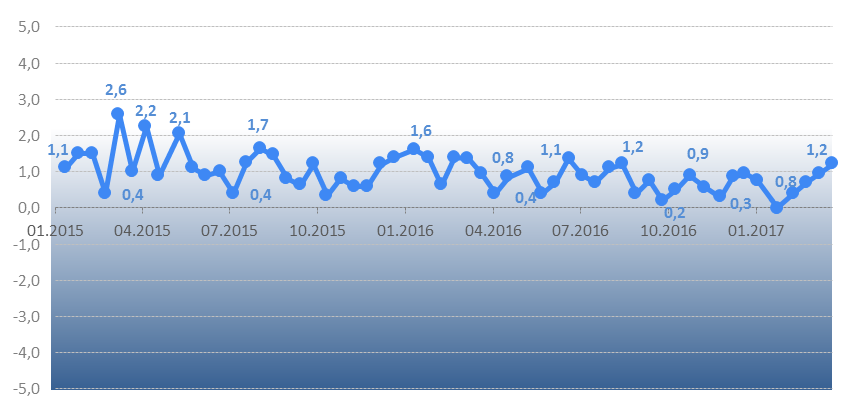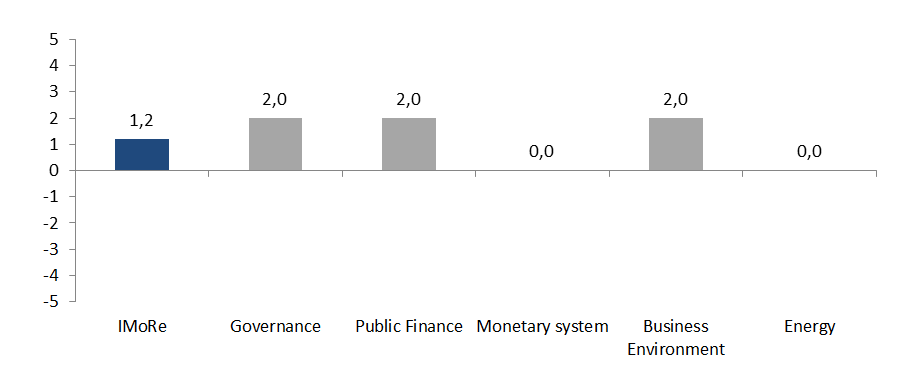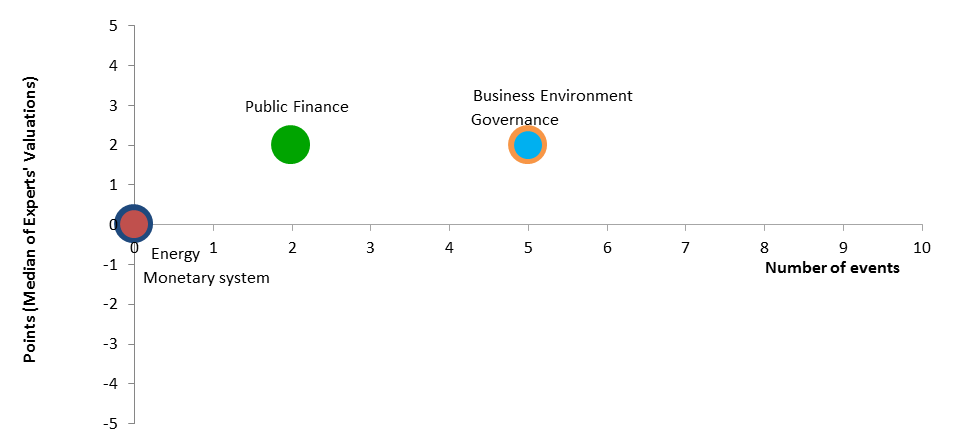Reform Index is growing slowly for the fourth round in a row. An assessment of the progress of reforms for the period of March 6 – March 19, 2017 is +1.2 points on a scale of -5.0 to +5.0. A positive shift was recorded in three out of five index components: governance, public finance, and business environment.
Among the major events that occurred during this round are the removing of obstacles to the amalgamation of communities, the introduction of a measure to reimburse citizens for drugs, and procedures for the appointment of the supervisory boards in public enterprises.
Chart 1. Reform Index dynamics*

* Reform Index team considers index value of at least 2 an acceptable pace of reform
Chart 2. Reform Index and its components in the current round

Top-reforms of the release
- Decentralization: removing of obstacles to the amalgamation of communities
Creating capable territorial communities is one of the key objectives of decentralization reform. These communities should meet the needs of inhabitants; provide them promptly and efficiently with basic social and administrative services, use effectively budgetary funds and other resources. Basic principles of forming capable communities are defined by the Law on voluntary amalgamation of territorial communities, which was adopted in February 2015. In the process of implementing this law, it was necessary to introduce additional mechanisms to work effectively. This is exactly what the laws, from the so-called “decentralization package” included into our survey are needed for.
The law, which determines the procedure of voluntary amalgamation of communities, +2.0 points
Law 1851-VIII of 09.02.2017 clarifies a number of provisions of the law “On Amalgamation of Territorial Communities” and amends the norms of the electoral law. It simplifies the procedure of voluntary accession of territorial communities, and allows the communities to join the existing amalgamated community under simplified procedures.
The law determines the conditions, the fulfilment of which allows a newly established territorial community being deemed as a capable one. Such a community should be established around a centre, specified in the Long-Term Plan of formation of territories of the communities, whereas not less than half of the number of residents provided for in the Long-Term Plan should be living in it. Each subsequent territorial community is acceded to this community under simplified procedures. Elections of members of the council of the amalgamated community are held in the acceded territorial communities, whereas election of the head of the amalgamated community is not held. Thus, representatives from all territories will be in the council of the newly established community.
The law on the powers of local mayors (starostas), the procedure and the reasons for their suspension, +1.5 points
Law 1848-VIII of 09.02.2017 defines the status of starosta in a village or a settlement, dimensional boundaries of his/her activities, and grounds and procedures for the early termination of powers etc. In particular, the current legislation introduces the concept of “starosta circuit.” Its boundaries coincide with the territory of the of the newly merged communities councils’ jurisdiction. The ubiquity of the institute of starostas within the boundaries of an amalgamated territorial community is being introduced. Starostas represent and protect the rights and legitimate interests of the inhabitants of villages and settlements.
The law on the acquisition of powers by the governor of the communities +1.0 point
Ukraine’s legislation prohibits village, town and city governor combine their official activity with the representative mandate or other work. Law 1850-VIII of 09.02.2017 introduces defence mechanisms to prevent violation of such requirements.
Chart 3. Value of Reform Index components and number of events, March 6-19, 2017

- Independent supervisory boards in the state enterprises
One of the requirements of the Association Agreement between Ukraine and the EU is to harmonize the legislation of Ukraine in the sphere of management of public enterprises with the Standards of Organization for Economic Co-operation and Development (OECD). These standards in Ukraine are imposed by the law on the management of state and municipal property, adopted in June 2016. The next step was to determine the procedure of establishing and functioning of independent supervisory boards and appointment (competitive selection) of their members in public enterprises. For this reason, the Government adopted two resolutions at the beginning of March 2017.
The procedure for the establishment, organization and liquidation of the supervisory board of the state enterprise and the appointment procedure (competitive selection) of independent members of supervisory boards have been approved, +2.0 points
CMU decree # 142 of 10.03.2017 allows to create the independent supervisory boards that will set the strategies for the development of public companies, appoint management, evaluate its work and appoint an independent auditor. The goal is to minimize the possibility of political interference into the work of public enterprises and reduce corruption risks.
The procedure for appointing state representatives to supervisory boards and participating in general meetings of entities of public economic sector have been approved, +2.0 points
CMU decree # 143 of 10.03.2017 establishes requirements and procedures for the appointment of state representatives to supervisory boards of state enterprises.
- Drug reimbursement program
The procedure for drug reimbursement and calculation of compensation +2.0 points
Government resolution #152 of 03.17.2017 provides for amendments to the CMU #862 and #863 of 11.09.2016 that establishes a mechanism of drug reimbursement for people with cardiovascular disease, type II diabetes and asthma.
It determines the possibility of full or partial reimbursement of drugs that will take part in the program of compensation according to the level of wholesale prices. The document also defines the list of international non-proprietary drugs, dosage and pharmaceutical forms. Such drugs should be included in the Register of medicines, the cost of which is refundable and will be approved by MoH Ukraine. The resolution also establishes boundaries for profit margin at 15% for retail pharmacies and spread profit margin for distributors at 10%.
Notes:
Reform Index aims to provide a comprehensive assessment of reform efforts by Ukraine’s authorities. The Index is based on expert assessments of changes in the regulatory environment in five areas: (Please see other charts here and here)
- Governance
- Public Finance
- Monetary system
- Business Environment
- Energy
For details please visit reforms.voxukraine.org
Attention
The author doesn`t work for, consult to, own shares in or receive funding from any company or organization that would benefit from this article, and have no relevant affiliations



